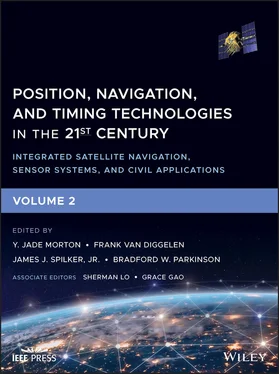37.5.1.3 Signal‐Property‐Based Methods
The triangulation‐based localization techniques discussed previously compute the distance to the mobile subject using either timing or angle information. But in the absence of LOS channels between transmitters and receivers, the underlying mechanism in both types of techniques (time and angle) are impacted by multipath effects, which can reduce the accuracy of the estimated location.
An alternative approach to measuring the distance of a mobile subject to some reference measuring nodes involves using the attenuation of the emitted (radio) signal strength. Theoretical and empirical models are usually used to translate the difference between the transmitted signal strength and the RSS into a range estimate. Such an RSSI is the most widely used signal‐related feature [52]. Typically, RSSI measurement estimations depend heavily on the environment, and are also nonlinear. Several techniques make use of RSSI with Wi‐Fi technology for indoor localization. As path loss models that are essential for such techniques are also impacted by multipath fading and shadowing effects [27], often indoor site‐specific parameters need to be used for these models. Some efforts have been proposed to improve accuracy in such cases; for example, [53] uses pre‐measured RSSI contours centered at the receiver to improve localization accuracy with cellular network signals, while [54] employs a fuzzy logic algorithm to improve Wi‐Fi RSSI‐based localization. In [55, 56], Bluetooth RSS was used to estimate distances and then an extended Kalman filter (EKF) algorithm was applied to obtain 3D position estimates.
Another approach to estimating distance is to use the signal phase (or phase difference) property [57]. As an example, assuming that all transmitting stations emit pure sinusoidal signals that are of the same frequency, with zero phase offset; then the receiver can measure the phase difference between the signals transmitted by the stations, which is a function of its location with respect to the stations. It is possible to use the signal phase approach together with ToA/TDoA or RSSI techniques to fine‐tune the location positioning. However, the signal phase approach is susceptible to interference along NLOS paths that can introduce errors.
Fingerprinting techniques refer to algorithms that estimate the location of a person or object at any time by matching real‐time signal measurements with unique location‐specific “signatures” of signals (e.g. Wi‐Fi RSSI). Typically, fingerprinting can be performed analytically or empirically.
Analytical fingerprinting, for example, RSSI‐based, involves using propagation models such as the radial symmetric free‐space path loss model to derive the distance between a radiating source and a receiver by exploiting the attenuation of RSSI with distance. Unfortunately, this simplistic model is rarely applicable in indoor environments, where the signals do not attenuate predictably with the distance due to shadowing, reflection, refraction, and absorption by the indoor building structures. Therefore, other models have been proposed, such as the Indoor Path Loss Model [58] and the Dominant Path Model [59], which takes into account only the strongest path, which is not necessarily identical to the direct path.
Empirical fingerprinting is more commonly used in various indoor localization techniques due to the difficulty in analytically modeling unpredictable multipath effects. There are typically two stages involved in such empirical location fingerprinting: an offline (calibration) stage and an online (run‐time) stage. The offline stage involves a site survey in an indoor environment, to collect the location coordinates/landmarks/labels and strengths (or other features) of signals of interest at each location. This procedure of site survey is time consuming and labor intensive. However, such a survey can account for static multipath effects much more easily than with analytical fingerprinting (although dynamic effects, e.g. due to different number of moving people are still problematic and can cause variations in readings for the same location). Several public Wi‐Fi APs (and also cellular network ID) databases are readily available [60–63] that can somewhat reduce survey overheads for empirical‐fingerprinting‐based indoor localization solutions; however, the limited quantity and granularity of fingerprint data for building interiors remains a challenge. In the run‐time stage, the localization technique uses the currently observed signal features and previously collected information to figure out an estimated location, with the underlying premise that the locations of interest each have unique signal features.
RSSI‐based empirical fingerprinting is used extensively in several indoor localization techniques. Many RSSI‐based fingerprinting solutions aim to utilize the existing infrastructure to minimize costs, for example, Wi‐Fi APs [65] and GSM/3G/4G cellular networks [66], while a few approaches advocate for custom beacon deployment for RF signal generation to support RSSI‐based localization [67, 68]. A GSM cellular network RSSI‐based indoor localization system is presented in [66]. Indoor localization based on a cellular network is possible if the locale is covered by several base stations or one base station with strong RSSI received by indoor cellular devices. The approach uses wide signal strength fingerprints, which includes the six strongest GSM cells and readings of up to 29 additional GSM channels, most of which are strong enough to be detected but too weak to be used for efficient communication. The additional channels help improve localization accuracy, with results showing the ability to differentiate between floors in three multi‐floor buildings, and achieving median within‐floor accuracy as low as 2.5 m in some cases. Typically, Wi‐Fi is the most common signal type used in RSSI‐based fingerprinting approaches. Figure 37.5illustrates how different locations often are covered by different Wi‐Fi APs or have different signal strength characteristics for the same Wi‐Fi AP, as can be seen from the two plots in the figure, allowing for unique fingerprinting and consequently, localization [64].
RADAR [65] was one of the first approaches to use Wi‐Fi RSSI for indoor localization. An offline phase was used to measure Wi‐Fi AP signal strengths across locations. Signal attenuations due to floors, walls, and other obstructions were also modeled, to improve the accuracy of the system to about 2–3 m in some cases. Several other indoor localization approaches use a similar strategy, for example, PlaceLab [69] and Horus [70]. Probabilistic (Bayesian‐network based) methods were employed in [71, 72] to improve the correlation between locations and Wi‐Fi RSSI during fingerprinting. In [73], a neural network classifier was used for Wi‐Fi RSSI‐based location estimation, with a reported error of 1 m with 72% probability. Wi‐Fi RSSI fingerprinting has also been widely used in the area of mobile robotics, to determine the location of a mobile robot assuming the availability of inputs from robot‐mounted sensors. A Bayesian robot localization algorithm was proposed in [74] that first computed the probability of a robot’s location based on the RSS from nine Wi‐Fi APs, and then as a second step exploited the limited maximum speed of mobile robots to refine the results (of the first step) and reject solutions with significant change in the location of the mobile robot. Depending on whether the second step is used or not, 83% and 77% of the time, mobile robots could be located within 1.5 m in their studies. A challenge in these fingerprinting‐based techniques is that two distant locations in an open indoor space may have similar signal fingerprints, which can be very problematic during localization [75]. Fingerprinting using the RSS of FM radio signals was proposed in [76]. As FM signals do not carry any timing information, which is a critical factor in range calculation using ToA, TDoA, and AoA methods, RSS‐based fingerprinting is the most viable approach when using FM signals for indoor localization. In [77], it was demonstrated that FM and Wi‐Fi signals are complementary; that is, their localization errors are independent. Further, experimental results indicated that when FM and Wi‐Fi signals were combined to generate fingerprints, the localization accuracy increased by 11% (without accounting for temporal variation) or up to 83% (when accounting for wireless signal temporal variation) compared to when Wi‐Fi RSSI only is used as a signature. A few efforts have also proposed Bluetooth RSSI‐based localization. Gimbal [67] and iBeacon [68] allow users to instrument their environment with custom Bluetooth‐based beacons and then use RSSI values received from these beacons on the user’s mobile device for indoor localization. Zigbee RSSI‐based localization has also been proposed in several works [2, 78, 79].
Читать дальше











